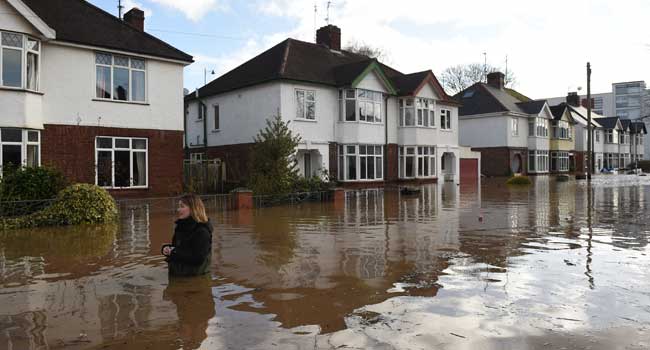Britain on Monday battled fallout from Storm Dennis
As hundreds of flood warnings remained in place after the second severe storm in seven days battered the country over the weekend.
The latest hazardous weather brought winds of more than 90 miles (140 kilometres) an hour and more than a month’s worth of rain in 48 hours in some places, leading officials to issue rare “danger to life” warnings.
“This is not yet over,” warned James Bevan, chief executive of the Environment Agency, which is responsible for flood protection.
“We still have many flood warnings in force and we may still see significant flooding in the middle of this week from larger rivers,” he told BBC radio.
Bevan said more than 400 homes in England had been flooded while at least 1,000 agency staff were working “to protect and support those communities which have been hit”.
The storm also pummelled much
of France, with some 20,000 people still without electricity on Monday after suffering power cuts in the northwest of the country and rail traffic disrupted.
– Major incidents declared –
In Britain, more than 600 warnings and alerts — a record number — were issued on Sunday, extending from the River Tweed on the border of England and Scotland, to Cornwall in the southwest.
After a day of torrential rain, major flooding incidents were declared in south Wales and parts of west central England.
Some three “severe” warnings — denoting lives could be endangered by the floodwaters — remained active later Monday on two rivers in the English region.
Hereford and Worcester Fire and Rescue service on Sunday airlifted to hospital one man pulled from the River Teme, who was in a stable condition on Monday.
Emergency responders also restarted the search for a missing woman swept away near the flood-prone town of Tenbury.
“Sadly, however, due to the circumstances of the length of time in the water and other conditions we believe that this will now be a recovery rather than rescue operation,” said Chief Superintendent Tom Harding, from West Mercia Police.
– Emergency responders –
Two rivers in south Wales burst their banks Sunday, prompting rescue workers to launch operations to evacuate hundreds of people and their pets trapped in their homes.
Police there said a man in his 60s died after entering the River Tawe, north of the Welsh city of Swansea, but later clarified that the death was not “linked to the adverse weather”.
Meanwhile the bodies of two men were pulled from rough seas off the south coast of England on Saturday as the storm barrelled in.
Britain’s Coastguard said it sent a helicopter and rescue team to join navy and other search vessels after receiving reports of a man overboard in the sea near Margate, Kent.
“After many hours of searching, a body was sadly found in the water… and was brought to shore,” it added.
Around the same time in nearby Herne Bay, emergency responders discovered another dead man following reports a person had been pulled from the sea, according to Kent police.
– ‘More extreme’ –
In northern England, the defence ministry deployed troops in West Yorkshire, hit by flooding from last weekend’s Storm Ciara.
There were fears rivers there could burst their banks.
Newly appointed environment secretary George Eustice said the government had done “everything that we can do with a significant sum of money” to combat increased flooding.
“We’ll never be able to protect every single household just because of the nature of climate change and the fact that these weather events are becoming more extreme.”
Youth climate activists from across Britain gathering for a national conference in Staffordshire, west central England, were forced to cancel the event due to the storm’s impact.
“There’s a bleak irony in our being beaten back by climate change,” 15-year-old attendee Sophia said in a statement released by organisers.
In a timely announcement the Met Office, Britain’s meteorological service, said Monday it would invest £1.2 billion ($1.6 billion, 1.4 billion euros) in a state-of-the-art supercomputer to improve forecasting.
The government claims it is the world’s “most powerful weather and climate supercomputer”.
jj/phz/pma



